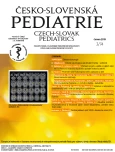Non-pharmacological treatment methods in children with epilepsy
Authors:
O. Horák
Authors‘ workplace:
Klinika dětské neurologie LF MU a FN Brno, Centrum pro epilepsie Brno, EU referenční centrum
Published in:
Čes-slov Pediat 2019; 74 (3): 146-152.
Category:
Overview
Over 70,000 people with active epilepsy, of which 30% with drug-resistant form – that‘s the situation in the Czech Republic, which makes epilepsy a serious health and socio-economic problem. However, even most of these patients can be helped by non-pharmacological treatment – surgically (= epileptosurgery) or using a ketotherapy. Both modalities are fully established in therapeutic management of epilepsies and their provision falls within the competence of specialized epilepsy centres.
Following article briefly summarizes the basic principles, efficacy, limitations and practical aspects
of treatment in both areas.
Keywords:
Epilepsy – pharmacoresistance – drug-resistance – epilepsy surgery – ketotherapy – ketogenic diet
Sources
1. Brázdil M, Hadač J. Definice farmakorezistentní epilepsie, příčiny intraktability. In: Brázdil M, Hadač J, Marusič P (eds). Farmakorezistentní epilepsie. Praha: Stanislav Juhaňák – Triton, 2011 : 12–22.
2. Scheffer IE, Berkovic S, Capovilla G, et al. ILAE classification of the epilepsies: Position paper of the ILAE Commission for Classification and Terminology. Epilepsia 2017 Apr; 58 (4): 512–521.
3. Brázdil M. Proměny epileptochirurgie ve 21. století. Neurol praxi 2015; 16 (2): 77–79.
4. Holland KD, Glauser TA. Response to carbamazepine in children with newly diagnosed partial onset epilepsy. Neurology 2007; 69 (6): 596–599.
5. Kwan P, Arzimanoglou A, Berg AT, et al. Definition of drug resistant epilepsy: consensus proposal by the ad hoc Task Force of the ILAE Commission on Therapeutic Strategies. Epilepsia 2010; 51 : 1069–1077.
6. Horák O. Dětská epileptochirurgie – specifika a současné trendy. Neurol praxi 2018; 19 (1): 11–15.
7. Horák O. Nefarmakologická léčba epilepsie u dětí. In: Ošlejšková H, et al. Aktuální kapitoly z dětské neurologie pro praxi. Olomouc: Solen, 2018 : 118–126.
8. Barba C, Specchio N, Guerrini R, et al. Increasing volume and complexity of pediatric epilepsy surgery with stable seizure outcome between 2008 and 2014: A nationwide multicenter study. Epilepsy & Behavior 2017; 75 : 151–157.
9. Lamberink HJ, Boshuisen K, Van Rijen PC, et al. Changing profiles of pediatric epilepsy surgery candidates over time: A natiowide single-center experience from 1990 to 2011. Epilepsia 2015; 56 (5): 717–725.
10. Cloppenborg T, May TW, Blümcke I, et al. Trends in epilepsy surgery: stable surgical numbers despite increasing presurgical volumes. J Neurol Neurosurg Psychiatry 2016; 87 : 1322–1329.
11. Hanáková P, Brázdil M, Novák Z, et al. Long-term outcome and predictors of resective surgery prognosis in patients with refractory extratemporal epilepsy. Seizure 2014; 23 : 266–273.
12. Baumgartner JE, Blout JP, Blauwblomme T, et al. Technical descriptions of four hemispherectomy approaches: From the Pediatric Epilepsy Surgery Meeting at Gothenburg 2014. Epilepsia 2017; 58 (Suppl 1): 46–55.
13. Simasathien T, Najm I, Gupta A, et al. Improved outcomes with earlier surgery for intractable frontal lobe epilepsy. Ann Neurol 2013; 73 (5): 646–654.
14. D’Argenzio LD, Colonnelli MCh, et al. Cognitive outcome after extratemporal epilepsy surgery in childhood. Epilepsia 2011; 52 (11): 1966–1972.
15. Marusič P, Brázdil M. Epileptochirurgické zákroky. Resekční zákroky. In: Brázdil M, Hadač J, Marusič P (eds). Farmakorezistentní epilepsie. Praha. Stanislav Juhaňák – Triton, 2011 : 1–207.
16. Brázdil M, Vojtěch Z. Semiinvazivní a invazivní video-EEG. In: Brázdil M, Hadač J, Marusič P (eds). Farmakorezistentní epilepsie. Praha: Stanislav Juhaňák – Triton, 2011 : 95–103.
17. Kršek P, Hadač J. Hemisferektomie. In: Brázdil M, Hadač J, Marusič P (eds). Farmakorezistentní epilepsie. Praha: Stanislav Juhaňák – Triton, 2011 : 220–222.
18. Brázdil M, Kalina M. Stimulace nervus vagus. In: Brázdil M, Hadač J, Marusič P (eds). Farmakorezistentní epilepsie. Praha: Stanislav Juhaňák – Triton, 2011 : 224–228.
19. Kuba R, Brázdil M, Kalina M, et al. Vagus nerve stimulation: Longitudinal follow-up of patients treated for 5 years. Seizure 2009; 18 : 269–274.
20. Horák O. Ketogenní dieta – účinná nefarmakologická léčba dětské a adolescentní epilepsie. Cesk Slov Neurol N 2019; 82 (1): 8–14.
21. Gaspard N, Hirsch LJ, Sculier C, et al. New-onset refractory status epilepticus (NORSE) and febrile infection-related epilepsy syndrome (FIRES): State of the art and perspectives. Epilepsia 2018; 59 (4): 745–752.
22. Neal EG, Chaffe HM, Schwartz R, et al. A randomised trial of classical and medium-chain triglyceride ketogenic diets in the treatment of childhood epilepsy. Epilepsia 2009; 50 (5): 1109–1117.
23. Freeman JM, Vining EP, Kossoff EH, et al. A blinded, crossover study of the efficacy of the ketogenic diet. Epilepsia 2009; 50 (2): 322–325.
24. Sharma S, Sankhyan N, Gulati S, et al. Use of the modified Atkins diet for the treatment of refractory childhood epilepsy: a randomized controlled trial. Epilepsia 2013; 54 (3): 481–486.
25. Lambrechts DA, de Kinderen RJ, Vles JS, et al. A randomized controlled trial of the ketogenic diet in refraktory childhood epilepsy. Acta Neurol Scand 2017; 135 (6): 231–239.
Labels
Neonatology Paediatrics General practitioner for children and adolescentsArticle was published in
Czech-Slovak Pediatrics

2019 Issue 3
- What Effect Can Be Expected from Limosilactobacillus reuteri in Mucositis and Peri-Implantitis?
- The Importance of Limosilactobacillus reuteri in Administration to Diabetics with Gingivitis
Most read in this issue
- Early diagnosis of severe primary immunodeficiencies, TREC/KREC assay
- Primary pulmonary hemosiderosis – experiences from Banska Bystrica
- Overview of new and even newer drugs for Duchenne muscular dystrophy and spinal muscular atrophy
- Fibromuscular dysplasia in a 2 years old child – casuistics
